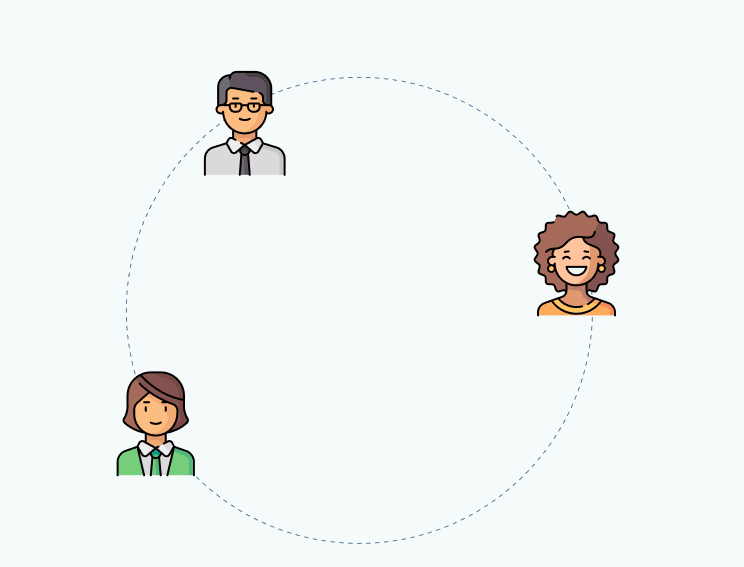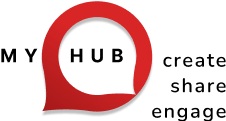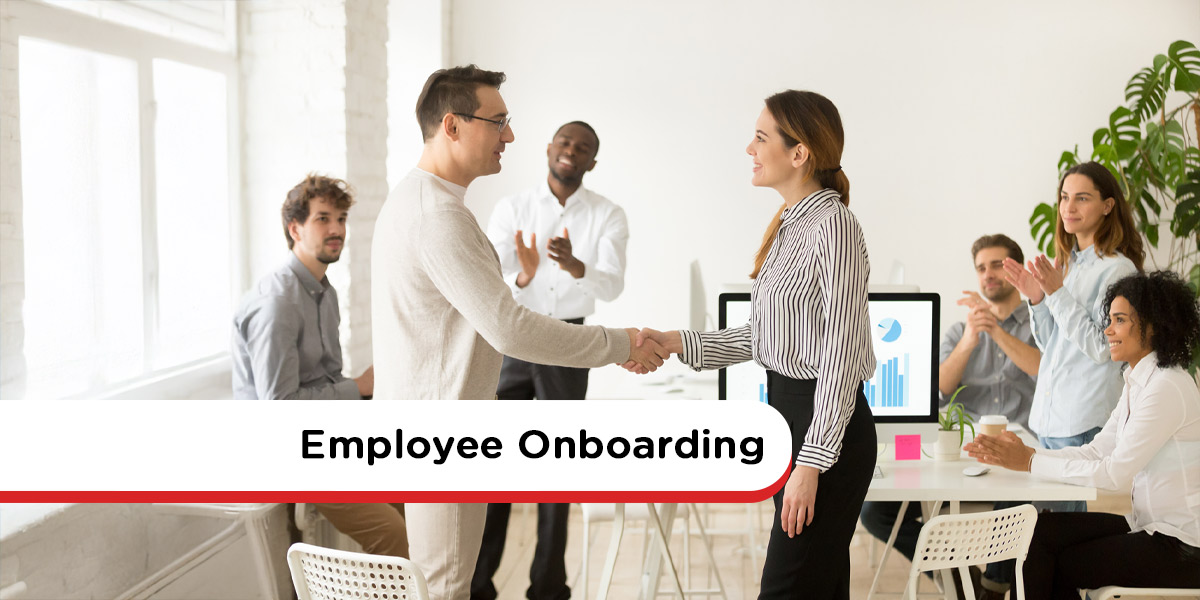
Your New Intranet Starts Here
Streamline communication, boost collaboration, and empower your team with MyHub's intuitive intranet solution.
Book a live demo now and experience the difference.
Take a Quick TourAfter months of advertising and interviewing, you have finally appointed that rock-star employee you’ve been searching for. Congratulations! However, if you want to develop a long and fruitful relationship with top talent, you need to implement an effective employee onboarding process.
Onboarding ensures your new hire feels part of the business and reaches their optimal performance level as quickly as possible. Plus, it’s your opportunity to create a solid first employee experience, which directly impacts long-term engagement, job satisfaction, and retention rates.
Let’s be clear: there’s a lot at stake. Get employee onboarding wrong, and you risk losing your new hire before they’ve even settled in. According to career specialists Zippia, workers who experience a great onboarding process are 69 percent more likely to stay with a company for three years. How you handle those first few days and months is crucial.
Below, we share expert-backed onboarding best practices that can be tailored to businesses of all sizes. Whether you’re a startup or an enterprise, these steps help ensure your onboarding strategy is robust and effective.
What Is Employee Onboarding?
Employee onboarding is the structured process a recruit follows to integrate into a new role and organizational culture. It goes beyond just having a working computer and a warm welcome. While those are important, onboarding is about creating a comprehensive framework to ensure every new employee has access to the information, resources, and relationships they need to succeed.
Successful onboarding means your new hire can confidently say:
- I feel at home in the organization.
- I understand my role and what’s expected of me.
- I know the company’s mission and how I contribute to it.
- I can access all necessary tools and systems to perform well.
- I’ve built strong relationships with team members and other departments.
- I have a positive, supportive relationship with my direct manager.
While often confused with orientation or induction, onboarding is more than a one-week introduction. It’s a strategic process that supports long-term employee development. Best practices suggest onboarding should last at least 90 days, with many companies extending it up to a full year depending on role complexity. The onboarding phase concludes when the new employee is fully productive and independent in their role.
Why Effective Onboarding Matters
Every HR leader knows that replacing an employee is costly. Studies estimate that the total cost of turnover can be 1.5 to 2 times the employee’s annual salary. According to Work Institute, voluntary turnover costs U.S. businesses over $630 billion annually.
Simply put, retaining employees is more economical than recruiting new ones. A strong onboarding process lays the foundation for long-term success, enhancing employee loyalty and reducing early attrition.
Hidden Costs of Poor Onboarding
It’s not just about the cost of hiring. Poor onboarding can result in:
- Lost productivity: New employees take time to reach peak performance.
- Poor customer experiences: Inexperienced hires may provide subpar service or make costly mistakes.
- Lower team morale: Turnover and poor integration can demotivate existing employees.
What the Research Says
The business case for investing in onboarding is clear. Here’s what the data shows:
- 77% of employees who experienced structured onboarding met their first performance milestones.
- 93% of employers said good onboarding significantly influences an employee’s decision to stay with the organization.
The takeaway? Comprehensive onboarding is an investment, not an expense. It accelerates the integration process, builds strong working relationships, and helps employees become productive, confident contributors much faster.
What Does Effective Employee Onboarding Look Like?
So, what does effective employee onboarding actually involve? If you’re responsible for designing or improving your company’s onboarding program, understanding the key stages is crucial. Below, we outline the five core phases that every successful onboarding strategy should include. These stages apply across industries and company sizes.
Best practice in employee onboarding programs identifies the following five stages:
- Pre-boarding
- The first day at work
- The first week
- The first 90 days
- The end of the first year
We’ll break down each stage in detail, covering the essential activities and key goals to ensure your onboarding process is both strategic and impactful.
Stage 1: Pre-Boarding – Setting the Stage for Success
Critical goal: Create a lasting first impression and introduce the new hire to your company’s culture, mission, and values.
What needs to happen: Pre-boarding begins immediately after the candidate accepts your offer. It’s your chance to start building a positive relationship and ease any pre-start anxieties. Instead of a standard email, consider giving the new hire a personal phone call to say congratulations. A small, human gesture can go a long way.
Follow up with a customized welcome letter. Be proactive by answering common questions that new employees often have, such as:
- What time should I arrive on my first day?
- Where is the office located?
- What should I bring?
- What are the lunch options nearby?
To reduce first-day nerves, some companies invite new hires for an informal pre-start visit. This gives them a chance to meet teammates and get familiar with the office layout.
You can also send select company materials in advance—like an annual report or a team introduction pack—to help them understand your business goals and prepare mentally for the new role. Don’t overwhelm, but do share thoughtfully curated documents that reflect your company’s identity.
Consider including a rough outline of their first-week schedule to show you’ve prepared for their arrival and value their presence.
Organizational Readiness for Onboarding
The pre-boarding stage is also your opportunity to ensure your organization is fully prepared to welcome the new team member. Make sure the following essentials are ready to go:
- Employment paperwork: Prepare employment contracts, tax forms, payroll enrollment, and your employee handbook.
- IT setup: Set up the company email, intranet access, project management tools, and software accounts. Don’t forget building access fobs and security credentials.
- Workstation preparation: Ensure a clean, functional workspace with a desktop or laptop, mobile phone (if applicable), business cards, and basic supplies.
- Team integration: Schedule introductory meetings with teammates and key departments so the new employee knows who’s who from the start.
- Assign a buddy: Pair the new hire with a workplace buddy who can answer questions, offer guidance, and act as a go-to support person during their first few weeks.
Pro tip: Double-check all arrangements a few days before their first day to avoid last-minute hiccups. A smooth pre-boarding process sets the tone for a professional and welcoming work environment.
First Day Onboarding: Creating a Memorable Start
Critical goal: To develop a personalized onboarding experience, making the employee feel welcome, valued, and excited about joining your team.
What needs to happen: Most new hires arrive on their first day feeling nervous and uncertain. A warm and structured welcome can ease this transition and set a positive tone. Ensure your reception staff are informed and ready to greet the new team member personally. The focus should be on orientation and integration. Here’s a checklist of essential first-day activities:
- Give a comprehensive office tour. Include essential areas such as restrooms, meeting rooms, printer stations, break rooms—and don’t forget the coffee machine!
- Host a team introduction meeting to foster a sense of belonging and collaboration.
- Plan a shared team lunch or take the new hire out for lunch to encourage informal bonding.
- Allow time for completing necessary onboarding paperwork and HR documentation.
- Provide quiet time to explore the company intranet, communication tools, and core business applications.
- Walk through company policies, employee benefits, health and safety procedures, and leave entitlements.
At the end of the day, check in with your new employee. A short debrief can resolve minor issues and leave a lasting positive impression.
The First Week: Building Understanding and Confidence
Critical goal: To help employees understand performance expectations and begin contributing meaningfully to the team.
What needs to happen: The first week of onboarding is critical for engagement. It’s the bridge between initial impressions and long-term success. Here’s how to support your employee:
- Arrange meet-and-greet sessions with key stakeholders and interdepartmental partners.
- Schedule 1:1 sit-downs with direct colleagues to encourage open communication and collaboration.
- Introduce the new hire company-wide via instant messaging tools or a welcome post on the intranet.
- Define initial tasks and clear objectives for the first 90 days.
- Offer quick, constructive feedback to reinforce confidence and align performance early.
- Maintain regular check-ins to identify and resolve potential roadblocks.
This phase builds trust and clarity, ensuring the employee knows what’s expected and feels supported.
The First 90 Days: Reinforcing Engagement and Performance
Critical goal: To solidify employee engagement, reinforce commitment, and ensure job confidence.
What needs to happen: By now, the employee should be somewhat settled and starting to contribute. The goal is to build on early progress and establish a rhythm. Key actions during this stage include:
- Continue weekly or bi-weekly 1:1 progress meetings to provide feedback and coaching.
- Define SMART goals and performance benchmarks for the next six months.
- Host a formal 90-day check-in to evaluate fit, morale, and career aspirations.
- Collect employee feedback on the onboarding experience for continuous improvement.
This stage helps transition new employees into confident contributors aligned with your company’s goals.
End Of The First Year: Transitioning From Onboarding To Retention
Critical goal: To shift focus from integration to career growth and long-term employee retention.
What needs to happen: At this stage, your employee should be a strong performer and a cultural fit. Now it’s about keeping them engaged for the long haul. Essential actions include:
- Conduct a formal performance review to reflect on achievements and opportunities.
- Establish new goals and strategic projects for the next 12 months.
- Initiate a career development conversation, including potential promotions or upskilling programs.
- Address any concerns or open questions from the employee’s perspective.
- Request comprehensive feedback on the entire onboarding journey to refine future processes.
Effective onboarding doesn’t end on day one—it evolves into employee growth and loyalty over time.
Comprehensive Employee Onboarding Checklist: The Five Phases
Our proven employee onboarding checklist covers the complete onboarding cycle, from pre-boarding to year-end review:
- Pre-boarding: Create a strong first impression by introducing company culture, mission, and values even before day one.
- First Day: Deliver a personalized and welcoming experience that reduces anxiety and fosters immediate engagement.
- First Week: Clarify expectations, assign tasks, and start building a strong working relationship.
- First 90 Days: Reinforce performance and develop confidence with structured goals and ongoing feedback.
- End of First Year: Transition to professional development and long-term retention strategies.
Use this checklist as a solid foundation to build your own tailored onboarding program. By doing so, you’ll ensure new employees integrate seamlessly into your organization and become high-performing team members faster.
Learn more about employee onboarding best practices here.
Employee Onboarding Checklist Template
You can download this checklist here: Employee Onboarding Checklist.pdf
| Onboarding Task | Completed By Whom & When |
| 1. Pre-boarding | |
|
|
| 2. First Day | |
|
|
| 3. First Week | |
|
|
| 4. First 90 Days | |
|
|
| 5. End Of The First Year | |
|
Key Benefits Of Using An Employee Onboarding Checklist For Managers
The bottom line is that an employee onboarding checklist lays a solid foundation for every new hire. From day one, expectations are clearly communicated, and the employee feels welcomed and supported within your organization.
Additionally, a structured checklist ensures no essential steps are overlooked. It guarantees every new team member experiences a consistent, well-organized onboarding process, regardless of department or role.
Achieving optimal performance quickly is just one part of the equation. An effective onboarding checklist delivers several long-term advantages for both employers and employees:
- Improved job performance: New hires gain access to all the tools, resources, and guidance they need to succeed, leading to faster productivity and goal achievement.
- Enhanced employee engagement: Whether focusing on employee experience, company culture, or overall morale, a strong onboarding process fosters deeper connections between staff and leadership.
- Lower stress levels: Onboarding checklists reduce anxiety for both managers and new hires by providing clear expectations and timelines.
- Increased job satisfaction: According to a recent survey, 92% of employees reported feeling valued and productive within the first month when onboarding was handled positively. This early satisfaction strongly influences long-term loyalty.
- Higher retention rates: As highlighted by the Harvard Business Review, companies with structured onboarding programs experience a 50% increase in employee retention.
Mastering the onboarding process impacts more than just performance. It shapes long-term employee engagement, satisfaction, and loyalty. Conversely, a poorly executed onboarding experience can lead to early resignations and wasted recruitment investment.
Customize your onboarding checklist to meet your organization’s specific needs — and make sure your top talent stays right where it belongs: with you.
Employee Onboarding Best Practices: Final Thoughts
Effective employee onboarding is a multi-step process that requires careful coordination. With so many moving parts, it’s easy to overlook crucial elements that can affect a new employee’s success and impression of your organization.
That’s why top-performing companies rely on checklists and automated onboarding workflows. These tools not only streamline the process but also ensure a standardized, high-quality experience for every new hire.
Onboarding checklists benefit managers by keeping everything on track — and they also empower employees by providing clarity, transparency, and structure from day one. It sends a clear message: your organization values people and is committed to their success.
In today’s competitive job market, shaped by the Great Resignation, candidates have more power than ever before. Failing to offer a compelling onboarding experience means risking the loss of skilled talent before they even get fully started.
Follow the onboarding best practices shared in this post to build a process that boosts retention, performance, and employee satisfaction.
MyHub provides cloud-based intranet solutions that streamline onboarding and internal communications. Our intuitive intranet software improves collaboration, connects dispersed teams, and simplifies onboarding with centralized portals and automated workflows. Discover how MyHub can elevate your onboarding process with a free demo or a 14-day trial.
FAQ Section
What is employee onboarding?
Employee onboarding is the process of integrating new hires into an organization, providing them with the necessary knowledge, skills, and behaviors to become effective contributors.
Why is effective onboarding important?
Effective onboarding improves employee retention, accelerates productivity, and enhances job satisfaction by ensuring new hires feel supported and aligned with company goals.
How long should the onboarding process last?
While initial orientation may last a few days, comprehensive onboarding should extend over several months to fully integrate the employee into the company culture and operations.




